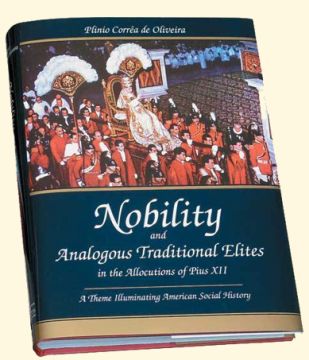|
Plinio Corrêa de Oliveira
Chapter VII
4. The Mutual Shaping of the Noble and the Nobility
|
|
|
a. Genesis—a process based on custom Seeing the nobility as it existed at its peak in medieval and post-medieval Europe, and also the image its admirers form of it today—whether in Europe or in the nations born of the Discoveries, the organizational genius of the European peoples, and the missionary zeal of the Church—we notice that it is rooted in certain coherent principles. These constitute a doctrine that has remained essentially the same semper et ubique, albeit with notable variations according to time and place. We can discern the germination of this doctrine in the mentality of the European peoples of the early Middle Ages as they shaped the nobiliary institutions, usually by way of custom. Historically, this doctrine reached its widest and most logical application at the height of the Middle Ages. This occurred in step with the full and harmonious expansion of feudalism and its ramifications in the political, social, and economic fields. We must emphasize that this theoretical-consuetudinary elaboration was carried out simultaneously and harmoniously not only by the noble families but by the rest of the social body as well, notably the clergy, universities, and other intermediate bodies. From intellectuals exploring the highest regions of human thought, down to modest bourgeois and simple manual laborers, everyone contributed to the process. This process is so natural that it continues in several fields even in our troubled century. b. Some examples Before the First World War, the German army was largely modeled by the idea that public opinion, deeply influenced by Prussian militarism, had of it. An analogous process had shaped the gestalt of Kaiser Wilhelm II, symbol of the army and the nation. A similar affirmation could be made (with less of a military note) about the idea public opinion in other countries had of their respective monarchs and armed forces, as, for example, Franz Josef in Austria and Edward VII in England. We use these historical examples because they are indisputable… if anything is indisputable in these matters.
As for the perenniality of this process, it suffices to mention the marriage ceremony of Charles and Diana, the Prince and Princess of Wales. The ancient and resplendent ceremony caused a universal wave of enthusiasm, which, in turn, strengthened the already classic psychological and moral profile expected of an heir apparent and his wife by the age-old yearnings of England. The ceremony also revealed the incidental modernizations the country wanted to introduce into this profile and, therefore, into the general physiognomy of the nation. These examples illustrate how a whole nation, with little clash among its currents, can gradually and prudently shape institutions like the nobility through a force of custom that is spontaneous, creative, conservative, and restorative. |
|

